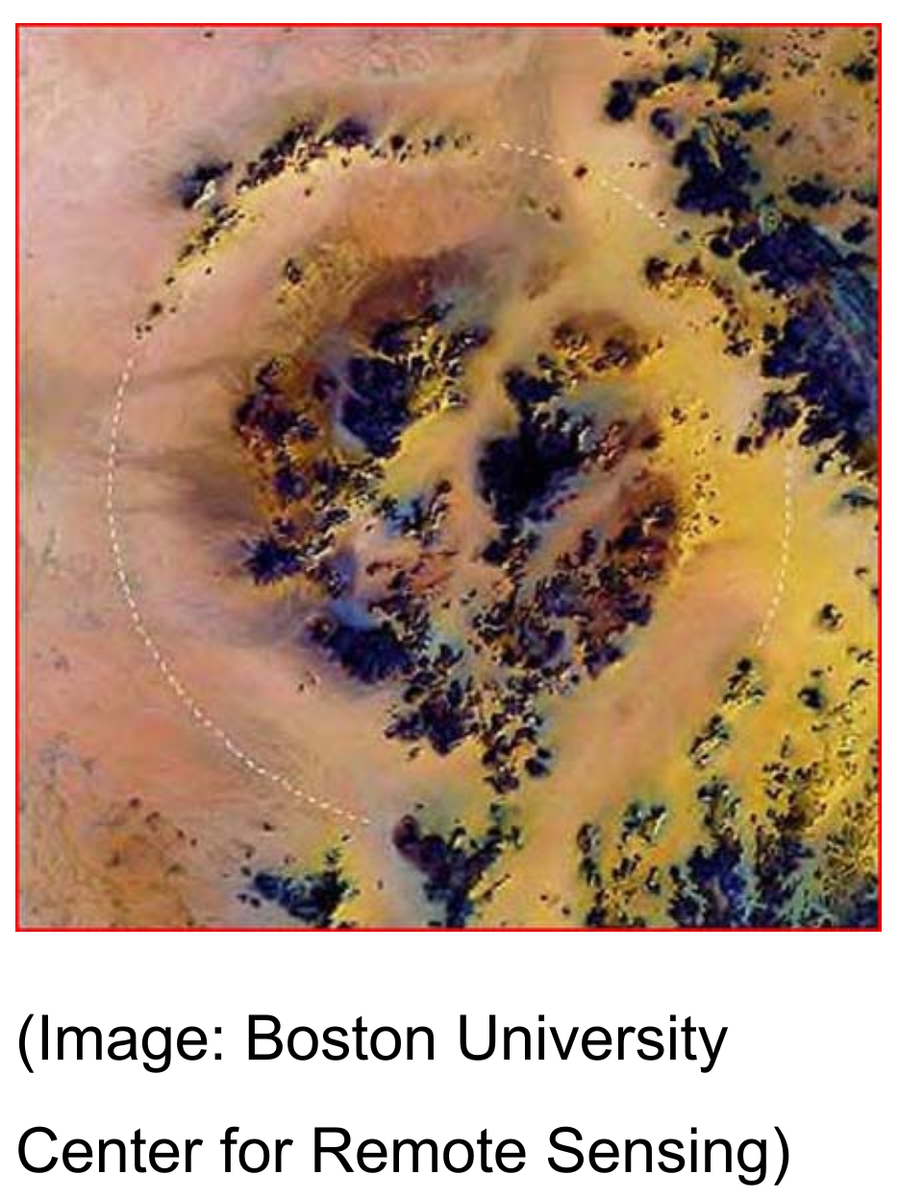[Libya's Kebira Crater リビアのケビラ・クレーター]

Landsat image of Kebira Crater in Egypt's Western desert, near the border with Libya.
リビアとの国境近くのエジプト西部の砂漠にあるケビラ・クレーターのランドサット画像。
―――――――
Apr. 24, 2006
この地域でこれまでに発見された中で最大のものと言われるサハラ砂漠の巨大なクレーターは、アリゾナの「メテオ(隕石)・クレーター」を矮小化しており、地質学者に新たな疑問を投げかけています。 クレーターは、この地域の神秘的な「砂漠のガラス」の起源と関係がありますか?
科学者たちは、何百万年も前の隕石の衝突が、上に描かれた巨大なクレーターの原因であると示唆しています。
この地域の衛星画像で最近発見されたクレーターは、エジプトの西部の砂漠にあります。
幅は約19マイル(31 km)で、直径がおそらく4分の3マイル(1.2 km)の隕石侵入者の衝突場所であると言われています。
クレーター自体は、アリゾナの有名なメテオ(隕石)・クレーターの25倍以上のサイズです。
しかし、時間が経つにつれて、風と水による侵食は古代の傷跡を大部分覆い隠しました。
この発見の興味深い側面の1つは、黄緑色のガラスの不思議なフィールドとの密接な関係です、エジプト南西部のグレートサンドシーの砂丘に散らばって、大きな塊に砕かれました。
黄緑色の「砂漠のガラス」の最初の報告は、ケビラ・クレーター・サイト近くのサード高原を通り抜けた後の1932年のパトリック・クレイトンからのものでした。
当時、ガラスの起源は不明でした:
ケイ砂をガラスに溶かす可能性のある地質学的力の証拠はありませんでした。
ケビラの発見により、ガラスの架空のソース(供給源)が利用可能になりました。
地質学者は、ガラスがケビラの衝突からの噴出物として発生したと推測しています。
ここに描かれているように、流星の衝突は周囲の珪砂に非常に多くのエネルギーを与えたので、それは溶けて爆発的に外側に投げ出され、固化して破砕したと考えられています。
ガラスはケビラの結果である可能性が高いですが、それが作成された方法は疑問の余地があります。
1.
ガラスが純粋すぎる―
これまでに見つかった中で最も純粋な天然シリカガラスのいくつかです。
ガラスの破片がテクタイト(火山または流星の衝突による溶融スラグ)の場合、それらは他のミネラルの存在を含むべきです。
2.
ガラスは、他の元素達を含む小さな内部気泡を示します。
それらの元素の1つはイリジウムであり、一般的な理論によれば、その存在は地球外起源を示しています(アルバレス、ルイス W.、et al。
「白亜紀-第三紀の絶滅の地球外の原因:
実験結果と理論的解釈。」
サイエンス 208(1980)1095-1108)。
しかしながら、ガラスは、岩塩やアルミナなど、この地域で見つかった他の鉱物の証拠を明らかにしていません。
3.
このタイプのガラスが見つかる可能性のある別の領域は、原子試験サイトです。
隕石のような固体の爆発でガラスが形成されなかった場合は、もう1つの方法があります―
巨大な放電です。
したがって、ガラスの破片は大きな閃電岩の残骸です。
〈https://www.mtholyoke.edu/courses/mdyar/database/fulg/fulg.gif〉
閃電岩は、稲妻が地球の耐火鉱物に当たると作成されます、ミネラルをクリストバライトなどの他の形に瞬時に製錬します。
実際、黄緑色のガラスには、イリジウムやその他の白金族元素とともに、クリストバライトの含有物が含まれています。
直径約19マイルの衝突場所を形成するのに十分な大きさの稲妻の力を与える場合は、追加の可能性も考慮する必要があります。
電気理論家は、非常にエネルギーの高い放電が元素を核変換すると長い間主張してきました―
恒星の表面で常に起こっているプロセスであると、彼らは主張します。
同じことが木星の月衛星イオにも暗示されています、そこでは、放電によって酸素が水氷から硫黄に連続的に変換されているように見えます。
(電気的理論家によると、エネルギッシュな落雷と「硫黄の悪臭」との関連は、老婆の話以上のものです)。
ケビラサイトは宇宙の落雷の傷跡ですか?
もしそうなら、調査の新しい方向性が不可欠になります。
_________________________
スティーブン・スミスによる寄稿
―――――――
Apr. 24, 2006
A huge crater in the Sahara desert, said to be the largest one ever found in the region, and dwarfing Arizona's "Meteor Crater", poses new questions for geologists. Is the crater related to the origins of the mysterious "desert glass" in the region?
この地域でこれまでに発見された中で最大のものと言われるサハラ砂漠の巨大なクレーターは、アリゾナの「メテオ(隕石)クレーター」を矮小化しており、地質学者に新たな疑問を投げかけています。 クレーターは、この地域の神秘的な「砂漠のガラス」の起源と関係がありますか?
Scientists suggest that a meteorite impact millions of years ago is the cause of the giant crater imaged above.
科学者たちは、何百万年も前の隕石の衝突が、上に描かれた巨大なクレーターの原因であると示唆しています。
Recently discovered in satellite images of the area, the crater lies in Egypt's western desert.
この地域の衛星画像で最近発見されたクレーターは、エジプトの西部の砂漠にあります。
It is some 19 miles (31kilometers) wide and is said to be the impact site of a meteoric intruder perhaps three-fourths of a mile (1.2 kilometers) in diameter.
幅は約19マイル(31 km)で、直径がおそらく4分の3マイル(1.2 km)の隕石侵入者の衝突場所であると言われています。
The crater itself is more than 25 times the size of Arizona's famous Meteor Crater.
クレーター自体は、アリゾナの有名なメテオ(隕石)クレーターの25倍以上のサイズです。
But over time, erosion by wind and water largely obscured the ancient scar.
しかし、時間が経つにつれて、風と水による侵食は古代の傷跡を大部分覆い隠しました。
One intriguing aspect of the discovery is its close association with a mysterious field of yellow-green glass, broken into large chunks, littering the dunes in the Great Sand Sea of southwestern Egypt.
この発見の興味深い側面の1つは、黄緑色のガラスの不思議なフィールドとの密接な関係です、エジプト南西部のグレート・サンド・シーの砂丘に散らばって、大きな塊に砕かれました。
The first report of the yellow-green “desert glass” came from Patrick Clayton in 1932, following his excursion through the Saad Plateau near the Kebira Crater site.
黄緑色の「砂漠のガラス」の最初の報告は、ケビラ・クレーター・サイト近くのサード高原を通り抜けた後の1932年のパトリック・クレイトンからのものでした。
At the time, the origin of the glass was unknown:
There was no evidence of geological forces that could have melted the silica sand into glass.
当時、ガラスの起源は不明でした:
ケイ砂をガラスに溶かす可能性のある地質学的力の証拠はありませんでした。
With Kebira’s discovery, a hypothetical source for the glass is now available.
ケビラの発見により、ガラスの架空のソース供給源が利用可能になりました。
Geologists speculate that the glass originated as ejecta from the Kebira impact.
地質学者は、ガラスがケビラの衝突からの噴出物として発生したと推測しています。
It is thought that the meteor strike imparted so much energy to the surrounding silica sand that it was melted and then explosively hurled outward, solidifying and fracturing into shards, as depicted here.
ここに描かれているように、流星の衝突は周囲の珪砂に非常に多くのエネルギーを与えたので、それは溶けて爆発的に外側に投げ出され、固化して破砕したと考えられています。
Although the glass is most likely a result of Kebira, the method by which it was created is open to question.
ガラスはケビラの結果である可能性が高いですが、それが作成された方法は疑問の余地があります。
1. The glass is too pure –
some of the purest natural silica glass ever found.
ガラスが純粋すぎる―
これまでに見つかった中で最も純粋な天然シリカガラスのいくつかです。
If the glass shards are tektites (melted slag from volcanoes or meteor impacts), they should include the presence of other minerals.
ガラスの破片がテクタイト(火山または流星の衝突による溶融スラグ)の場合、それらは他のミネラルの存在を含むべきです。
2. The glass does exhibit small internal bubbles that include other elements.
ガラスは、他の元素達を含む小さな内部気泡を示します。
One of those elements is iridium, the presence of which indicates an extra-terrestrial origin, according to prevailing theories (see Alvarez, Luis W., et al.
それらの元素の1つはイリジウムであり、一般的な理論によれば、その存在は地球外起源を示しています(アルバレス、ルイス W.、et al。
"Extraterrestrial Cause for the Cretaceous-Tertiary Extinction: Experimental Results and Theoretical Interpretation."
Science 208 (1980) 1095-1108).
「白亜紀-第三紀の絶滅の地球外の原因:
実験結果と理論的解釈。」
サイエンス 208(1980)1095-1108)。
However, the glass reveals no evidence of other minerals found in the region, such as halite and alumina.
しかしながら、ガラスは、岩塩やアルミナなど、この地域で見つかった他の鉱物の証拠を明らかにしていません。
3. Another area where this type of glass may be found is atomic test sites.
このタイプのガラスが見つかる可能性のある別の領域は、原子試験サイトです。
If the explosion of a solid object, like a meteor, did not form the glass, then there remains one other method available—
an enormous electrical discharge.
隕石のような固体の爆発でガラスが形成されなかった場合は、もう1つの方法があります―
巨大な放電です。
The glass shards, then, are the remains of large fulgurites.
したがって、ガラスの破片は大きな閃電岩の残骸です。
〈https://www.mtholyoke.edu/courses/mdyar/database/fulg/fulg.gif〉
Fulgurites are created when bolts of lightning strike refractory minerals in the earth, instantaneously smelting the minerals into other forms, such as cristobalite.
閃電岩は、稲妻が地球の耐火鉱物に当たると作成されます、ミネラルをクリストバライトなどの他の形に瞬時に製錬します。
The yellow-green glass does, in fact, contain cristobalite inclusions, along with the iridium and other platinum family elements.
実際、黄緑色のガラスには、イリジウムやその他の白金族元素とともに、クリストバライトの含有物が含まれています。
If one grants the power of a lightning bolt large enough to form an impact site some 19 miles in diameter, then additional possibilities must also be considered.
直径約19マイルの衝突場所を形成するのに十分な大きさの稲妻の力を与える場合は、追加の可能性も考慮する必要があります。
Electrical theorists have long claimed that highly energetic electric discharge transmutes elements—
a process that is going on all the time on the surface of stars, they contend.
電気理論家は、非常にエネルギーの高い放電が元素を核変換すると長い間主張してきました―
恒星の表面で常に起こっているプロセスであると、彼らは主張します。
The same thing is implied on Jupiter's moon Io, where electric discharge appears to be continuously transmuting oxygen from water ice into sulfur.
同じことが木星の月衛星イオにも暗示されています、そこでは、放電によって酸素が水氷から硫黄に連続的に変換されているように見えます。
(The association of energetic lightning strikes with a "sulfurous stench" is much more than an old wives' tale, the electrical theorists say).
(電気的理論家によると、エネルギッシュな落雷と「硫黄の悪臭」との関連は、老婆の話以上のものです)。
Is the Kebira site the scar of a cosmic thunderbolt?
ケビラサイトは宇宙の落雷の傷跡ですか?
If so, new directions of investigation will be essential.
もしそうなら、調査の新しい方向性が不可欠になります。
_________________________
Contributed by Stephen Smith
スティーブン・スミスによる寄稿